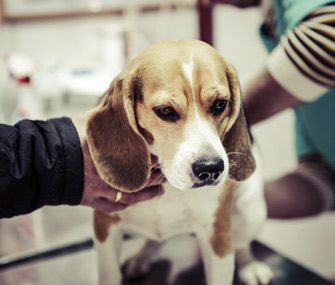Heartworm Treatment for Dogs: What You Need to Know
Published on November 26, 2013

Odds are, you’ve visited at least one veterinary office that prominently displayed a photo or drawing of a canine heart infested with heartworms. This gruesome image illustrates what can happen to your dog when the spaghetti-like worms clog his heart.
As a dog owner, you’re probably aware of the risks of heartworm disease, and I hope you are taking precautions to prevent it. But beyond gawking in horror at the poster in the vet’s examining room, have you ever thought about what’s involved in treating heartworm? Believe me, it’s not a simple matter for your dog or for you.
Step One: Pre-Adult Heartworm Treatment
Once your dog is diagnosed with heartworm disease, your veterinarian may recommend a course of antibiotics, heartworm preventives and steroids before beginning the actual adult worm treatment.
Antibiotics may be prescribed because a bacterium found living inside the heartworms — Wolbachia — is thought to contribute to an inflammatory response within the body. When the heartworms die, they release the bacteria into the dog’s body. Researchers believe the presence of Wolbachia may cause the body to mount an immune response that could worsen not only the heartworm disease but also the lung and kidney inflammation seen in dogs with this condition.
For this reason, many veterinarians begin treatment by prescribing doxycycline, based on promising results from published studies of doxycycline use in dogs infected with heartworms.
Since the heartworm treatment only kills adult worms, veterinarians may prescribe a monthly heartworm preventive to kill the smaller larvae before initiating adult heartworm treatment.
The administration of corticosteroids at the same time as the antibiotics and heartworm preventive also helps reduce inflammation.
Step Two: Treating the Disease
Once your dog has completed the course of steroids, heartworm preventive and antibiotics, he should be ready to start the actual adult heartworm treatment. The treatment for heartworm disease takes at least 60 days to complete and consists of a series of drug injections that kills the worms. There is only one drug approved by the Food and Drug Administration to kill adult heartworms in dogs, an organic arsenical compound that is injected into the dog’s lumbar, or back, muscles.
On the days injections are given, your dog must stay in the hospital for observation to make sure he doesn’t have any serious reactions to the treatment. Your veterinarian may also prescribe a tapering dose of steroids for a period of time following the injections.
But, wait, there’s more! Your dog should be retested after treatment and six months later to ensure that all of the larvae, microfilariae and adult worms are dead. Dogs who remain heartworm positive six months after treatment may need to repeat treatment to kill the remaining worms.
Step Three: Quiet Time
During treatment and for several weeks afterward, your dog’s activity level must be limited. Fragments of dead worms can block blood flow through pulmonary vessels and worsen the inflammatory response; too much exercise increases blood flow to blocked areas, causing capillaries to rupture as the body tries to pump blood through the blocked vessels. This heightens the likelihood of complications, such as coughing, breathing difficulties and sudden death. Because of this, a highly active dog with only a small number of heartworms is more likely to develop severe heartworm disease-associated signs than a dog with many heartworms who’s a couch potato.
To reduce the risk of complications, it’s essential that you restrict exercise for the entire time your dog is undergoing treatment and for a period of time afterward. Depending on the severity of the damage caused by the heartworms, this can mean complete confinement in a crate except for potty walks on leash or minimal activity in the home, with only brief walks on leash and crating when no one is there to monitor his activity and make sure he remains calm.
Your veterinarian will let you know when your dog can resume normal activity levels.
When Surgery May Be Necessary
Not every case of heartworm disease can be treated medically; sometimes the worms are found not only in the heart but also in a large vein called the caudal vena cava, located between the liver and the heart. In that situation, surgical removal of worms may be necessary.
Fortunately, drug treatment for dogs with heartworm disease is usually successful, especially if the dog has only mild signs of disease. A dog with more severe heartworm disease can also recover, but he runs a higher risk of complications and even death. For these reasons, the best cure of all is prevention. Ask your veterinarian about your dog’s risk level and be sure you’re doing everything you can to stop heartworm disease before it starts.
The Importance of Dog Health Insurance
Dog health insurance can help you pay for unexpected health expenses, surgeries, or medications. It’s important to purchase insurance before there’s a problem. While pet insurance may add to your monthly expenses, it can save you hundreds or thousands of dollars in the long run.
Don’t ever let financial decisions get in the way of your dog’s care. Review personalized options for your pet below:

